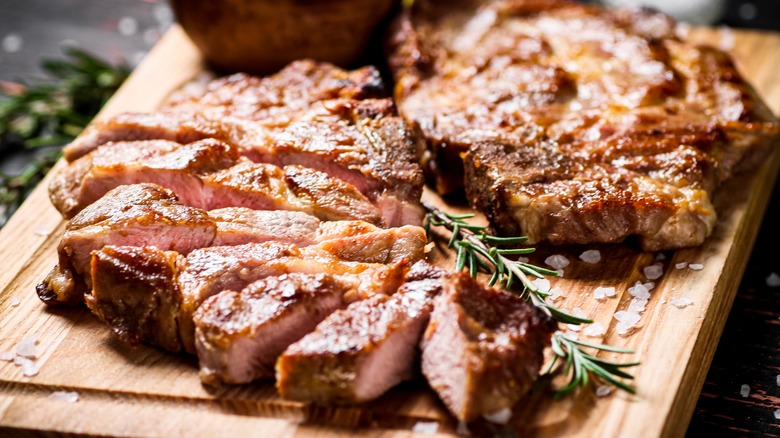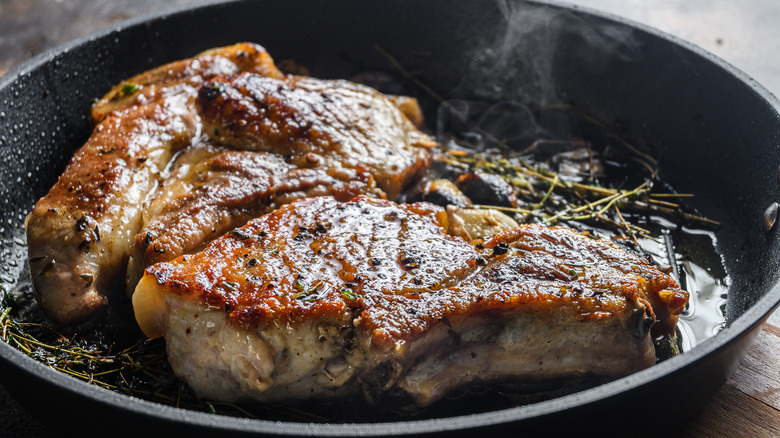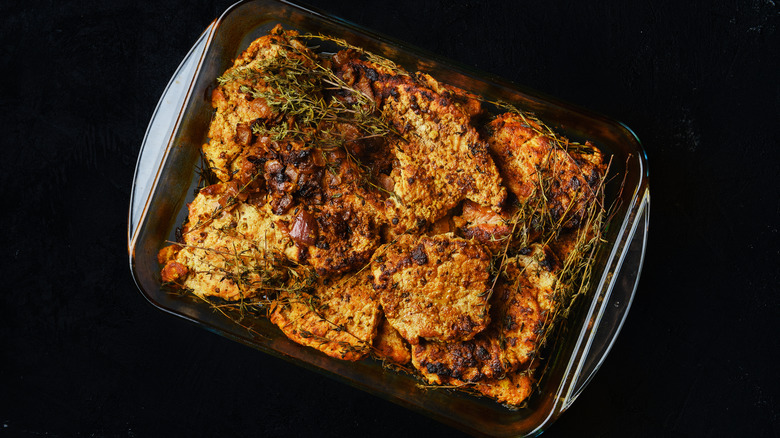The 2-Step Method To Make Sure You Don't Overcook Pork Chops
Pork chops are a fantastic go-to meal at home. They're usually easy to find at your local grocery store and don't hit the wallet too hard. Plus, they can be prepared quickly — one of those items you can grab from the fridge and decide to make last-minute, and still be sitting down at the table in under 30. You can cook them up on your choice of stove, oven, or grill for a protein that goes well with a plethora of flavors, from a rosemary butter sauce to an apple chutney to a briny caper topping.
But there's one thing about pork chops that proves to be the thorn in every pork chop maker's side: They are notoriously easy to overcook. While this cut of meat has the potential to be perfectly tender and juicy, it's a thin line — they're tender until they're not, and that line creeps up very quickly. And what's the last thing you want from lean meat? For it to be tough, dry, and overdone. No thank you.
While there are plenty of ways to cook and prepare them, there's one way that's foolproof for cooking pork chops to an ideal tenderness, ensuring you don't cross that dreaded line.
Pan sear the chops
The first step is to sear your chops on the stove. Why? Because the goal is to keep the meat as tender as possible, and what helps keep meat tender is the juice inside of it. Pan-searing the pork chops will help lock in those essential juices while giving them a nice brown, flavorful crust to cut into. Pro tip: Brine the meat for anywhere from 30 minutes to several hours beforehand, to both help tenderize the meat and give it more flavor.
There are a few key preparations that will help you complete this first step successfully. The best way to ensure a good, effective sear is a hot, preheated pan paired with room temp meat. One of the most important things to do before you cook a pork chop (or any meat, really) is to make sure the meat isn't cold when it hits the pan — and chef Samin Nosrat, the author of the well-known cookbook "Salt Fat Acid Heat," agrees. "If it's cold on the inside," she explains to TODAY, "what's going to happen is the outside is going to get totally dried out and overcooked by the time you get the inside cooked." That's exactly what we don't want.
Once you add your chops to the hot, oiled pan over medium-high heat, let them sear untouched for about three minutes until that crispy outer layer forms. Then flip 'em, and it's on to the next and final step.
Bake the chops in the oven
As soon as you flip the pork chops, it's time to transfer your pan to the oven, which should be preheated to about 400 degrees Fahrenheit. Don't worry about searing the other side — the Kitchn explains that the still-very-hot pan will work on browning that side of the meat while the rest of it finishes cooking in the oven.
This change in cooking method is what helps ensure the meat doesn't overcook, because the even, slower heat of the oven cooks the pork chops through with more control, allowing the inside to cook as much as the outside, as opposed to the high, often uneven heat of your pan or skillet. You should only need around eight minutes in the oven, depending on the size of your pork chops, and when they reach 140 to 145 degrees Fahrenheit on your meat thermometer, they are done.
This method works great for any type of pork chop, whether thin and lean or thick and bone-in — just adjust the cooking time accordingly and keep an eye on the internal temperature. It's just a one-two punch to serve up perfectly juicy, flavorful pork chops, every single time.


